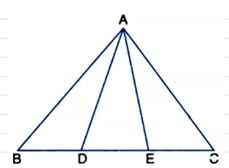Four points A(6,3),B(−3,5),C(4,−2) and D(x,2x) are given in such a way that (AreaofDBC)(AreaofABC)=12.Solution in Tamil
The correct Answer is:116
Area ofΔDBCArea ofΔABC=12
or 12[x(5+2)−3(−2−2x)+4(2x−5)]12[6(5+2)−3(−2−3)+4(3−5)]=12
or 7x+6+6x+8x−2042+15−8=12
or 3x−27=12 or x=116
Topper's Solved these Questions
- COORDINATE SYSYEM BOOK - CENGAGECHAPTER - COORDINATE SYSYEM EXERCISE - Exercise 1.3
10 Videos
- COORDINATE SYSYEM BOOK - CENGAGECHAPTER - COORDINATE SYSYEM EXERCISE - Exercise 1.4
8 Videos
- COORDINATE SYSYEM BOOK - CENGAGECHAPTER - COORDINATE SYSYEM EXERCISE - Exercise 1.1
6 Videos
- COORDINATE SYSTEMBOOK - CENGAGECHAPTER - COORDINATE SYSTEMEXERCISE - Multiple Correct Answers Type
2 Videos
- CROSS PRODUCTS BOOK - CENGAGECHAPTER - CROSS PRODUCTS EXERCISE - DPP 2.2
13 Videos
Similar Questions
If point P(3,2) divides the line segment AB internally in the ratio of 3:2 and point Q(−2,3) divides AB externally in the ratio 4:3 then find the coordinates of points A and B.
View SolutionThe line joining the points (x,2x)and(3,5) makes an obtuse angle with the positive direction of the x-axis. Then find the values of x.
View SolutionWhat is the minimum area of a triangle with integral vertices ?
View SolutionCoordinates of points on curve 5x2−6xy+5y2−4=0 which are nearest to origin are
View SolutionLet →a and →b be two vectors of equal magnitude 5 units. Let →p,→q be vectors such that →p=→a−→b and →q=→a+→b. If |→p×→q|=2{λ−(→a.→b)2}12, then value of λ is
View SolutionD is the mid-point of side BC of ABC and E is the mid-point of BD. If O is the mid-point of AE , prove that ar(BOE)=18ar(ABC)
View SolutionFour points A(6,3),B(−3,5),C(4,−2) and D(x,2x) are given in such a way that (AreaofDBC)(AreaofABC)=12.
View SolutionIf ABC and DEF are two triangles such that ABDE=BCEF=CAFD=25 , then Area(ABC):Area(DEF)= 2:5 (b) 4:25 (c) 4:15 (d) 8:125
View SolutionFour points A(6, 3), B(−3, 5), C(4, −2) and D(x, 3x) are given in such a way that DBCABC=12 , find x .
View SolutionABCD is a parallelogram, G is the point on AB such that AG=2GB,E is a point of DC such that CE=2DE andF is the point of BC such that BF=2FC. Prove that: ar(ADEG)=ar(GBCE)
View SolutionABCD is a parallelogram, G is the point on AB such that AG=2GB,E is a point of DC such that CE=2DE and F is the point of BC such that BF=2FC. Prove that: arEGB=16ar(ABCD)
View SolutionABCD is a parallelogram, G is the point on AB such that AG=2GB,E is a point of DC such that CE=2DE and F is the point of BC such that BF=2FC. Prove that: ar(EFC)=12ar(EBF)
View SolutionABCD is a parallelogram, G is the point on AB such that AG=2GB,E is a point of DC such that CE=2DE andF is the point of BC such that BF=2FC. Prove that: ar(EBG)=ar(EFC)
View SolutionIn Figure DandE are two points on BC such that BD=DE=EC Show that ar(ABD)=ar(ADE)=ar(AEC)

View SolutionFour points A(6,3), B(−3,5), C(4,−2)and D(x,3x) are given in such a way that ΔDBCΔABC=12,find x
View Solutionint(sum_(r=0)^(oo)(x^(r)backslash2^(r))/(r!))dx=(A)e^(x)+C(B)(e^(2x))/(2)+C(C)-(2)/(1-2x)+C(D)2e^(2x)+C
View Solution
